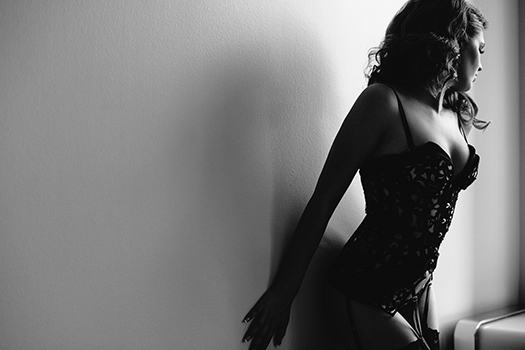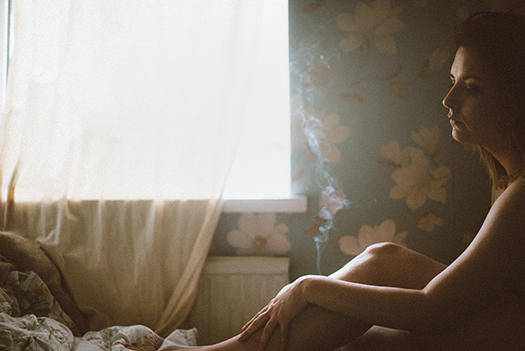Everything You Need to Know to Start Your Boudoir Business
August 29, 2016
How It’s Defined
I never thought of boudoir as needing to stay within the traditional realm of how it was traditionally shot. “Intimate lifestyle photography” has become the label I use because it expresses the meaning that so many of our clients have found in their session experience. I wanted to shoot them in a much more lived-in, voyeuristic manner. It is our call-to-action—helping men, women, gay, straight or no category—to be able to express who they are freely. Intimate lifestyle photography for me is about being part of this larger movement demonstrating our clients’ strength, sensuality, vulnerability and sexuality all in one. —Ewan Phelan
Staying on Brand
There are several styles of boudoir, so it’s important to continue to photograph in a way that matches your other brand. Callaway Gable is in the luxury wedding market, so it’s important that we photograph our clients in a way that’s classy, feminine and empowering. It’s not about what we show, but rather more about subtlety, a hint of what’s there. It’s looking for nuance by framing parts of her body. In fact, we have had several non-nude boudoir shoots, and that’s okay. What’s important is capturing her true self. —Brian Callaway
Prepping Clients for Sessions
One of the best tools you can give your clients is a prep list before their session. It’s a way to set expectations and trouble-shoot potential questions, alleviating lots of back and forth communication. And while this is a helpful tool for your client, it’s also a way for you to gently present things that you want and don’t want to take place. If you want to ensure your client moisturizes their skin in the days leading up to their session, or if you are not a photographer who uses props, you can state this right in the prep list so you don’t have to worry about being put on the spot if someone shows up for their session with a bunny costume. —Brianna Phelan
Gear on Set
I’ve only ever used the one lens to get what I need: a Nikon 50mm f/1.4. Using the one lens really makes me consider how I shoot, as well as having the added benefit of simplicity for the client, where they’re not waiting for me to decide on a lens whilst they’re in a state of undress. Changing lenses in front of the model brings a cold, stark technical element to the shoot. I prefer to keep the conversation going, and I find I get the best results when the idea of the camera melts away. —Nick Murray

Photo © Brian and Allison Callaway | Callaway Gable
Posing Perspectives
Ewan Phelan: I speak quietly to my clients and give direction in a very concise and non-threatening manner. I never ask my clients to “get on all fours,” making them self-conscious about what they are doing, but rather ask them to place their knees in one position and their hands in another. Giving very direct and specific instructions takes away any doubt from the client about what they should be doing.
Brian Callaway: Make sure her shoulders are down. Have her take deep breaths to help her relax. Look for her neck and pull her hair back on the part that is closest to the camera. Create an S shape with her body so her waist is accentuated as small—this works well with plus-size women because you can create a more flattering photograph.
Nick Murray: We’ll throw some music on and I’ll just shoot when an idea materializes. Occasionally I’ll suggest they move their arm, or to lift their head slightly, but the process is so organic. I’ve found the greatest inspiration happens when the person is open to ideas and their movement is fluid. Sometimes I’ll set up a pose just to shoot the few moments after I ask them to stop posing; those fleeting seconds when they relax are golden and can produce some of the best work.

Photo © Ewan and Brianna Phelan
Locations
Studio
Pros: The most reliable for your clients and you, allowing for quick trust-building because they know you’re busy enough to require a dedicated location and that you know the space inside and out.
Cons: It always has that “studio” feel to it, and it’s sometimes hard to get that lived in, voyeuristic feel; it can get repetitive and take away some of the challenge of shooting. —EP
In-home Studio
Pros: The same pros as a studio, plus as a home it provides a more comfortable feeling.
Cons: The same cons as a studio, plus a client may not want to just come into your home when they are making a large financial investment in the session. —EP
Hotel
Pros: Very convenient, especially if you are a traveling photographer.
Cons: Some hotels have rules against business being carried out without permission, and it is often hard to find a hotel that has the aesthetic you’re looking for. —EP
Airbnb
Pros: The same benefits of an in-home studio, plus they’re great for travel.
Cons: Can have the same problems as hotels. Speaking with the Airbnb owner beforehand is very important so you don’t find yourself having to exit right before one of your scheduled shoots. —EP
Client’s Home
Pros: Makes your client relax, and each home provides fresh perspectives—the colors, textures and light are always diverse.
Con: From a purely organizational point of view, some clients have children and large pets that obviously can’t be there. —NM

Photo © Nick Murray
Getting Clients without Marketing
There are no boudoir photographs on our website, blog or social media. We want her to immediately know that her privacy is paramount. When she initially contacts us about her wedding she must answer a questionnaire—one of the questions asks about how she feels about boudoir. Has she ever thought about it? If her reply is positive we will talk about it during our initial phone consultation. We will also send a private gallery of previous boudoir sessions. (It’s important to note that our previous clients have all approved the use of their images; privacy and trust are integral.) If a client comes into our studio for a wedding consultation, we will have a tasteful boudoir book and a box of matted photographs in the stack of wedding books. In our experience, an interested client will let you know right away. —BC
The Importance of a Contract
The worst mistake you can make is shooting a client without a signed contract. This is your opportunity to have all agreed-upon details in one place, dated and signed. A verbal agreement is not adequate and you always want a paper trail. Your contract should include dates, payment schedules and everything that your client is responsible for (like providing their own lingerie). It should also state the penalties if the agreements are not met. This ensures that your client knows exactly what they are receiving and there is no confusion. A contract protects you, the photographer. It states exactly what you are responsible for providing and protects you if you end up in court. Ensure that you update it as you encounter new situations, and have it approved by your lawyer. Purchasing a professional contract online will save you a big headache, with the work already being done for you. —BP
Shooting Boudoir as a Man
It is important to show as much work as possible in order to help gain trust. When clients see that other women, men or couples have trusted you to photograph them, it is easy for your potential client to imagine themselves being photographed by you. As a man shooting this style of photography for over a decade now, I have to say that I have only had a couple of potential clients have issue with the fact that I’m a man photographing. As many other clients have said, they preferred that I was a man. —EP
Album Sales
The best way we have found to encourage album sales is by asking clients how they want to view their images 30 years from now. Do they want to be huddled around a computer trying to discreetly take peek, or would they rather flip through the pages of an album while curled up in front of a fire? With the rapid changes of technology, there’s no guarantee that digital files will be relevant down the road. It’s important to have an album collection to show clients.
—BP
Dealing with Backlash
I’ve been lucky enough to have had only one critic (that I know about) and that was via an anonymous reporting on Facebook. I did my very best to make sure that all of the images more than met Facebook’s guidelines before I posted, but somebody still took offense. Facebook disagreed with the report and the image was back up in no time. I’m sure there’s more criticism to come in the future, but harsh words don’t phase me. Nothing great was ever achieved by worrying about negativity. Some people will get it and some won’t, but at the end of the day, it’s all about shooting for yourself, and nobody knows you better than you. Take criticism lightly, but you have to stay true to yourself and your artistic vision. —Nick Murray
Brian Callaway created the award-winning wedding photographer studio Callaway Gable with his wife, Allison, both of whom are frequent educators.
Nick Murray is a wedding photographer in the UK who expanded to boudoir fairly recently. He shoots with a Nikon D750 and a 50mm f/1.4 using only available light.
Ewan and Brianna Phelan have been shooting intimate lifestyle photography for 12 years. They’re also co-founders of Do More Wear Less, an education and networking platform for boudoir photographers.
CreativeLive Video Tutorial: Boudoir on the Edge, Hosted By Ewan and Brianna Phelan
Related: Boudoir Digest: The Latest Trends in a Burgeoning Game




